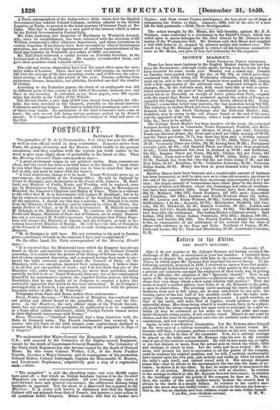fetus to tbt elan.
THE MOON'S ROTATION.
December 27. Sin—I do not wonder at Mr. Jelinger Symons not having accepted the challenge of Mr. Hill, as mentioned in your last number. I ventured three years ago to dispute the question with himin the columns of the Hereford Times, in which paper Mr. Symons first launched his novel theory. To the following question, proposed an 1856, I received no answer from that gentle- man, although he honoured me by a reply to other points in the argument— a process not unknown amongst the employers of that ready, way of getting out of a difficulty, the adoption of the Ignoratio elenchi. ' Now, to ask again of Mr. Symons my first question—a physical one—why is the moon's shape that very shape which a slow axial rotation will produce ? That the moon is nearly a perfect sphere, very little, if at all, flattened at the poles, is open to observation. The growing curve marking the limits of light and darkness, from new to full moon' can be seen and tested by any eyes : the waning curve of the last half of her monthly course bears the same testi- mony—that, in common language, the moon is round. A quick rotation, as that of the earth, still more that of Jupiter, would produce an oblate spheroidal shape. Her shape being what it is would seem, then, to be a physi- cal proof that the atoms composing her mass were so arranged by a slow ro- tation (it may be estimated at ten miles an hour), the polar and equa- torial diameters being nearly, if not exactly, equal. Shapes do not come by chance, and the laws of the physical universe are uniform under similar cir- cumstances, and not capricious. Again, to take a mechanical illustration. Let Mr. Symons place himself on the very axis of a railway turntable, and let it be turned round. Mr. Symons will then, I presume, perform a revolution on his own axis, carried round as he will be on that of the turntable. Now, let a railway carriage be placed on the table, and let Mr. Symons take his seat in the exterior seat of one of the exterior compartments. He will be now some six, or eight, or ten feet distant, or more, from the actual axis on which the whole, table and carriage, is about to turn. Let the table now be so turned : Mr. Sy- mons will present his face in succession to all the points of the compass, until be resumes his original position, and he will, I contend, mechanically have turned upon his own axis, just as truly and really as when he stood on the table's axis itself, and turned round with it. His strange delusion seems this—that he allows to the movement in the one case the name of ro- tation; he denies it in the other. In fact, he seems quite to misconceive the nature of all motion. Motion is relative as well as absolute. In relation to the carriage in which he sits, Mr. Symons does not turn round ; in relation to the buildings around the points of the compass, he does so. To deny, then, the reality of the axial motion merely because the moon's face is always to the earth is a simple fallacy. In relation to the earth's star- gazers the moon does not visibly rotate ; in relation to the sun she does so— that is, she has an absolute and true rotation round an axis within herself. I am Sir, your obedient servant, T. W. W.


























 Previous page
Previous page